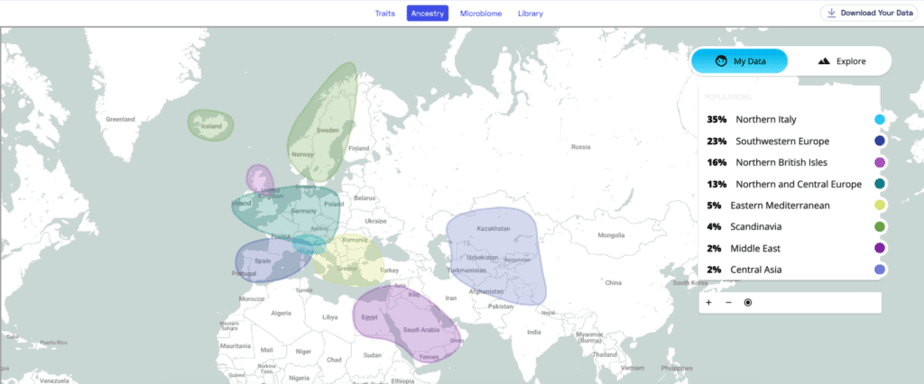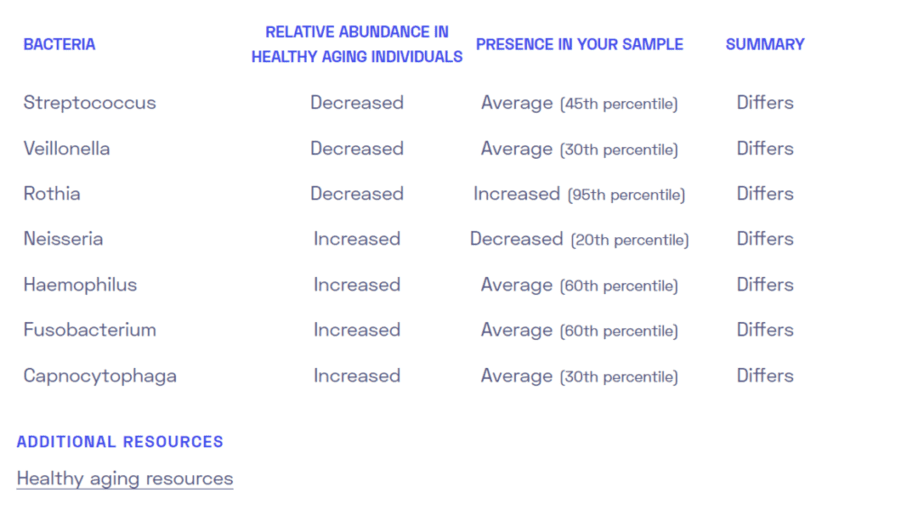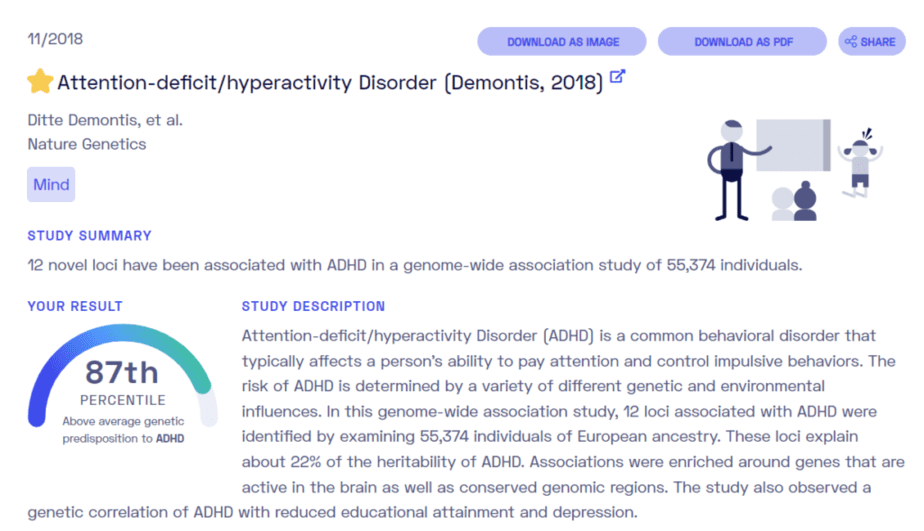We created Nebula Explore to give people a way to have their whole genome sequenced while maintaining privacy and ownership of their data. Just order a kit, supply a sample, register it to your Nebula account, and return it to us––we’ll provide you with reports on oral microbiome, ancestry, sleep patterns, athletic performance, personality traits, physical appearance, dietary restrictions and more within 8-10 weeks!
For those who are on the fence about getting sequenced or just want more info on what our reporting provides, we’re pleased to provide a walkthrough of an example report.
Viewing your Reporting
Nebula will notify you via email once your results are ready to view, and all you will need to do then is log into your Nebula user account here and click on the “Reporting” tab.

Upon logging in, you’ll see the above page. Your reporting will contain up to four subtabs, highlighted by the red box at the top of the image. These include Traits, Ancestry, Oral Microbiome and the Nebula Library (the Nebula Library is available only available for Explore Subscribers). By default you’re started off on the “Traits” subtab, so we’ll explore that one first.
Traits
The “Traits” subtab contains info on your inherited traits; essentially, these are certain qualities that you are more or less likely to possess based on your unique genome. As seen in the image below, your traits are organized into four subcategories. For this walkthrough we’ll take a look at the traits in the “Body & Athleticism” category.

Clicking on the View Category button will reveal a summary of all traits within that category.
Note: Some traits are labeled “new”; this is because if you’re subscribed to Nebula Explore, we’ll be consistently adding new traits to your report over time.

For an example of what each trait includes, we’ll take a closer look at the Jimmy Legs trait. At the top of each trait summary, you’ll find the name of the trait, which gene it is associated with, and which variant is being looked at for the trait (this refers to the specific location in your DNA sequence that we’re looking at). You’ll also receive info in bold on how you express the trait based on your genome, and below that, you’ll receive a description of what the trait means. For more details, click the “Learn more” button at the bottom of the summary, which will produce the pop-up seen below on the right:

Here you’ll find a more in-depth description of what the trait is, how the gene is associated with it, and what your specific variant says about you, including your actual genotype (which bases/letters you have at this location in your DNA sequence). If you want to read the actual paper we used as the basis of our reporting for this trait, you can click on the “Read Paper” button to view that source.
Ancestry
Next, we’ll show you what your ancestry results could look like by navigating to the Ancestry view. Your view will default to the Explore option where you can see all possible regions that we check for ancestry.

The My Data option will give you a breakdown of your ancestral heritage. You will be shown the estimated % of your heritage from regions that were discovered by sequencing. For more info about which groups each region consists of, simply click into the region. We will upgrade the resolution of our ancestry analysis over time and we’ll inform you when those updates come out, so stay tuned!

Oral Microbiome Report
Nebula’s whole-genome sequencing allows us to provide all users with a report of their Oral Microbiome – the unique collection of bacteria living in their mouths. We are the first and ONLY personal genomics company that is providing Oral Microbiome reporting.
How is this possible? Unlike most DNA testing companies, we use next-generation DNA sequencing. This technology enables us to sample all DNA that is present in a saliva sample. Most of it belongs to you, but some of it comes from the bacteria living in your mouth.
There is a growing body of research that links various diseases with changes in the oral microbiome. For example, the oral microbiome has been found to change in people suffering from gastrointestinal diseases like inflammatory bowel disease (IBD), systemic diseases like diabetes and even neurological diseases such as Alzheimer’s. We are hoping to give our users access to more useful research and personalized content with exclusive features like Oral Microbiome reports.
For each bacterium found in your OMB, we provide its relative abundance, which is its percent composition relative to the total number of bacteria. For example, a relative abundance of 5% means that this bacterium makes up 5% of your oral microbiome.
Second, we calculate a percentile that tells you how the relative abundance in your sample compares to other people. For example, the 90th percentile means that 90% of people have a lower relative abundance of this bacterium.
Third, we provide access to curated research studies that demonstrate links between oral microbiome composition and various diseases. However, it is important to keep in mind that correlations do not imply causation or predict disease onset. This is not a diagnostic test and we provide you these results for educational purposes only.

Here you can learn how the oral microbiome of people with various medical conditions compares to your oral microbiome composition. However, please keep in mind that our results are not perfectly comparable to the findings of various publications due to differences in testing methods. We also provide additional information relevant to the study and link to other sources that we think you might find interesting. As new research is published, we will curate the new findings and make them available to you.

The *New* Nebula Library!
We are excited to announce the new and improved Nebula Research Library – with the new and improved Nebula Library, you will still be able to stay up to date with the latest discoveries in human genomics and discover how they may relate to you, but now the meaning of that research is more intuitive to grasp with the help of polygenic scores. Library content is updated weekly and there will never be a shortage of new insights for Explore subscribers!
After clicking on the Nebula Library tab you will be greeted with the Library feed, which will consist of all the curated research articles to that day. You can organize this feed based by selecting the Sort By option at the top-right and choosing to sort by; Newly Added, Date Published, or Polygenic Score.
Additionally, each article is tagged with one or more terms that are connected with certain articles. Tags you can explore today: Addiction,Aging, Alcoholism, Allergy, Autoimmunity, Behavior, Bladder, Blood, Bones, Brain, Breasts, Cancer, Dementia, Development, Eyes, Heart, Hormones, Infection, Inflammation, Intelligence, Intestines, Joints, Kidneys, Liver, Lungs, Mind, Mouth, Nose, Obesity, Pancreas, Pregnancy, Prostate, Senses, Sex, Skin, Sleep, Stomach, Throat, Thyroid, Vasculature

As you scroll through the Library feed, preview article reports will appear consisting of the research article title, along with publication date, lead author and name and publication journal. Underneath the title are the search tags associated with that article entry. We then provide a summary of the study along with some additional information that is relevant to the condition studied and explain the function of the genes in which restless legs syndrome-associated variants have been discovered.
Note: While you explore the Nebula Research Library please keep in mind that it should be used for informational and educational purposes only. If a study indicates that a specific variant that may be present in your genome is associated with a certain condition, this does not mean that you either have or will develop this condition. We do not provide any medical advice, and the library is not intended to be used for any diagnostic purpose. Please always seek the assistance of a health care provider with any questions regarding your health.
Polygenic Scores
Previously, the Nebula Research Library contained studies with the discovered genetic variants listed in tables. However, because everyone typically carries a different combination of many genetic variants, it can be difficult to interpret what a list of genetic variants mean in the context of one’s own genome. To address this issue, we have updated the format of the Nebula Research Library. Now, in addition to providing tables that list discovered genetic variants, we calculate two numbers for most of the studies. The first number is a polygenic score. It summarizes the effect of all genetic variants discovered in the study and present in your genome. The second number is a percentile that is calculated for the polygenic score. It tells you how your polygenic score compares to the scores of other Nebula Genomics users
The genome’s roughly 20,000 genes work in a similar way. A particular trait or disease can be the work of a single gene — for example, blood type and cystic fibrosis. But the most common conditions and traits, such as heart disease, diabetes, height, and intelligence, are the result of multiple genes functioning in combination. In fact, hundreds, even thousands of genes can work together, each one exerting a slight influence on human biology. Today scientists are developing ways to better dissect these polygenic traits — that is, which genes and genetic variants contribute and how much?
A common approach is to calculate polygenic scores, which are the sum of (usually small) effect sizes of many genetic variants. Polygenic scores can help determine an individual’s genetic propensity toward a particular trait or disease. In some cases, these polygenic risk scores are becoming useful tools for doctors— for example, identifying patients who are likely to suffer a heart attack despite having low cholesterol. However, it is important to remember that genes tell only part of the story. The vast majority of health conditions are also influenced by environmental factors including lifestyle.
The figure below shows a typical Nebula Research Library entry. This user has a polygenic score for attention deficit hyperactivity disorder (ADHD) that was calculated from ADHD-associated variants identified in this study. This score places the user into the 87th percentile, which means that they have a higher polygenic score for ADHD (based on variants identified in this study) than 87% of our users.

The first two columns of the table did not change in this update. They contain the variant IDs and the alleles – versions of a variant – that have been found to be associated with a trait or disease, which is ADHD in the example.
Next, come three new columns that we added in this update. The first column lists effect sizes which are the contributions of different alleles to the polygenic score. Some alleles have positive effect sizes and increase the score (highlighted in green) while other alleles have negative effect sizes and decrease the score (highlighted in blue). Alleles not present in your genome do not affect your polygenic score (not highlighted).

The allele frequencies in the second column tell you the percentage of people in the population that carry each of the listed alleles.
The third new column shows the statistical significance for each of the associations discovered in a study. These numbers are called p-values. The smaller the p-value, the more certain it is that the discovered association between a trait and a genetic variant is real. We include only variants that show a highly significant association with a trait and sort them in the tables from most to least significant.
The last column in the table did not change in this update. It shows your genotype – the two alleles you have inherited from your parents – and an estimated accuracy of our prediction. Note that we account for this uncertainty when calculating your polygenic scores. If the accuracy is low, then the contribution to the polygenic score is reduced.
Proceed with Caution
We would like to emphasize that the scores that we calculate are much less predictive than polygenic risk scores that are used for diagnostic purposes. The latter is carefully calibrated and often incorporate millions of genetic variants — covering nearly the entire swath of the genome — whereas our scores include only a small set of the most significant variants. This means our polygenic scores are a rough estimate and should only be used for educational purposes. They are not intended for medical or diagnostic use. In addition, as we described above, genes are not necessarily destiny. If you have a particular variant associated with a disease in your genome, it does not mean you will develop that disease. The same goes for polygenic scores. A high polygenic score/percentile for a particular disease does not necessarily mean a significantly increased disease risk, because many genetic effects remain undiscovered and environmental factors almost always play a major role. As always, if you have any questions about your health, please seek the advice and input of a healthcare provider.
Join Us Today
Enter the age of personal genomics and learn about how the latest discoveries relate to your DNA by ordering our whole-genome sequencing or get started for free by uploading your 23andMe/AncestryDNA data!
